
European Credit Transfer and Accumulation System (ECTS)
The European Credit Transfer and Accumulation System (ECTS) is a crucial framework designed to help students and universities navigate the workload associated with lectures and study programs. While it may seem complex at first glance, ECTS is relatively straightforward. This article aims to clarify the most frequently asked questions about the system.
What is ECTS?
The ECTS is a standardized points system utilized by universities across Europe, established through agreements among governments to facilitate international education. It enables greater comparability of academic achievements across borders within the European Higher Education Area (EHEA).
This system ensures that the credits assigned to a course or module are equivalent at different universities. As a result, students can study in various European countries during their academic journey with relative ease. The ECTS facilitates the recognition of courses taken abroad, allowing students to earn credits for their semester or year spent studying outside their home institution.
One of the key advantages of ECTS is its flexibility. Students can accumulate credits from various institutions toward a single degree or qualification, making it easier to tailor their education to their interests and goals.
Currently, the ECTS framework is embraced by 48 countries across the EHEA, which stretches from Portugal in the West to Russia and Kazakhstan in the East. This widespread adoption underscores the system's significance in promoting mobility and accessibility within European higher education.
In summary, the ECTS serves as a vital tool for enhancing the transparency and comparability of academic programs across Europe, enabling students to explore diverse educational opportunities while ensuring their efforts are recognized and rewarded.





